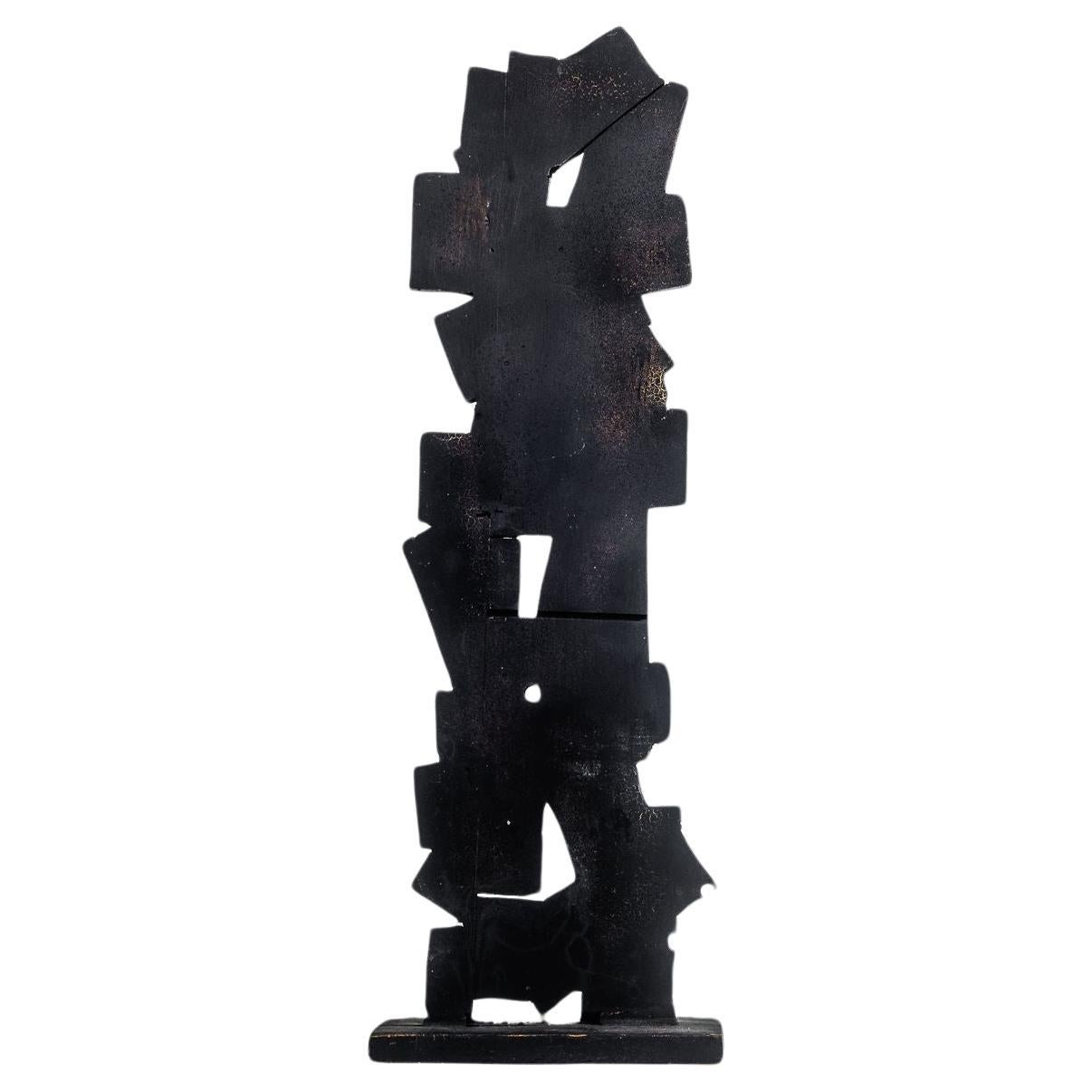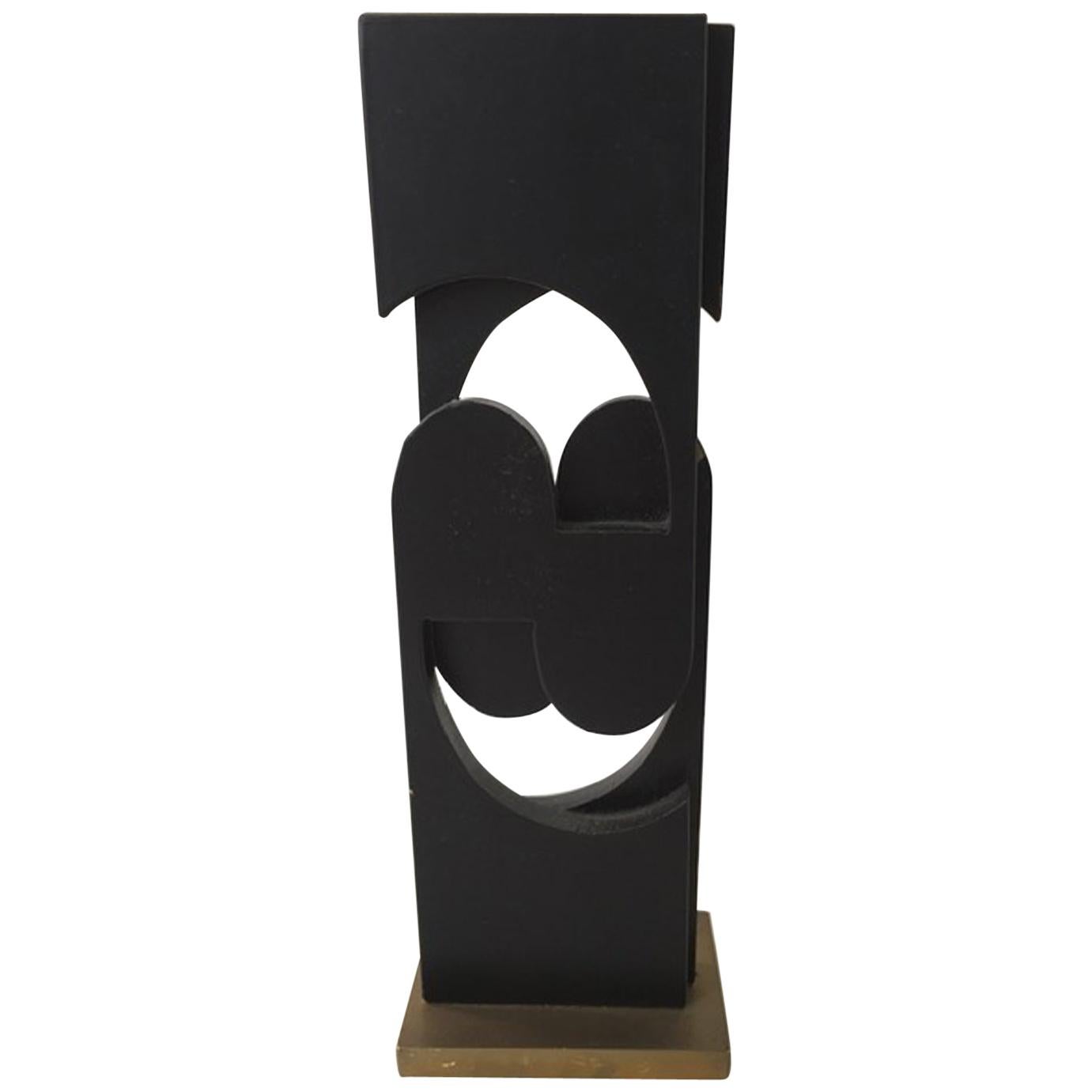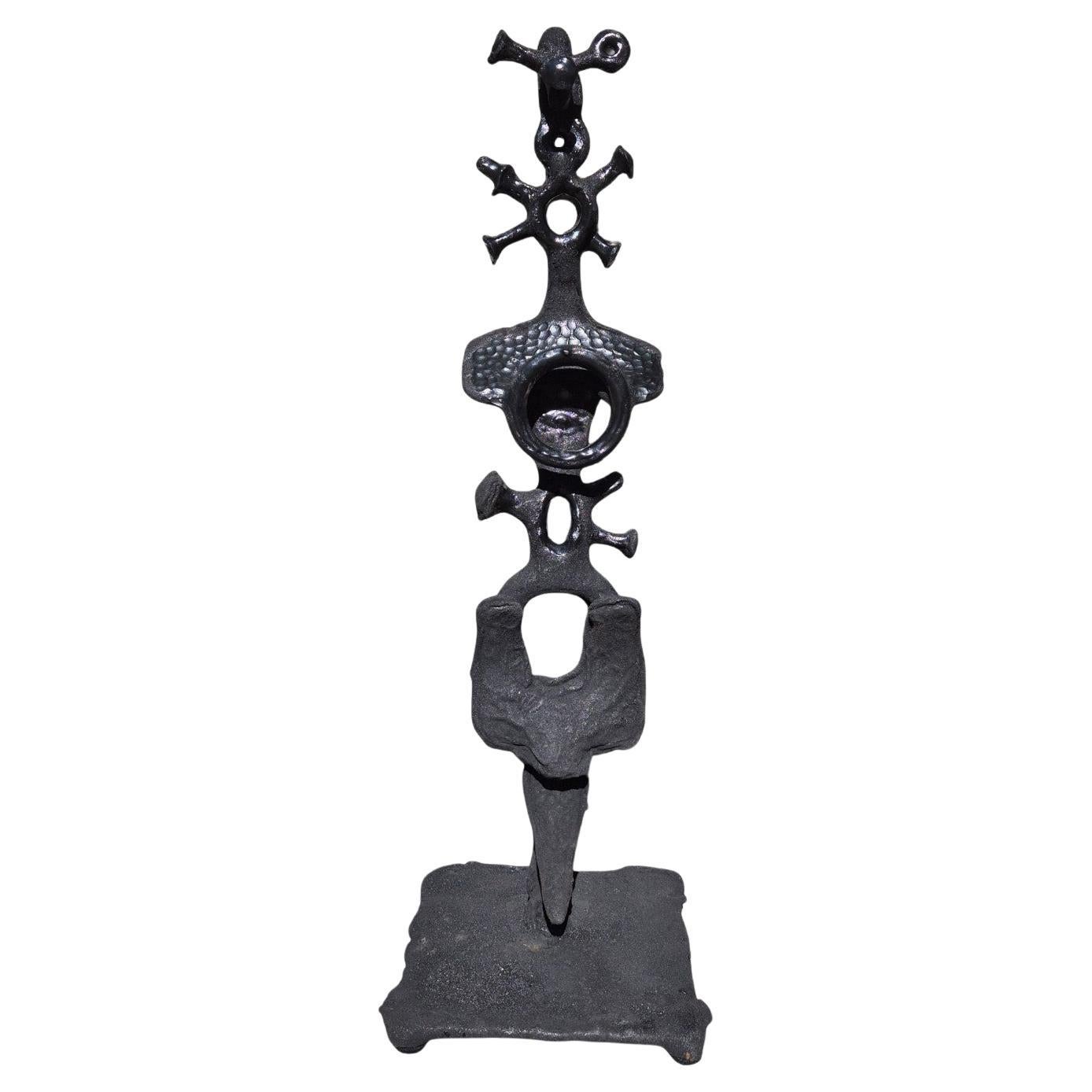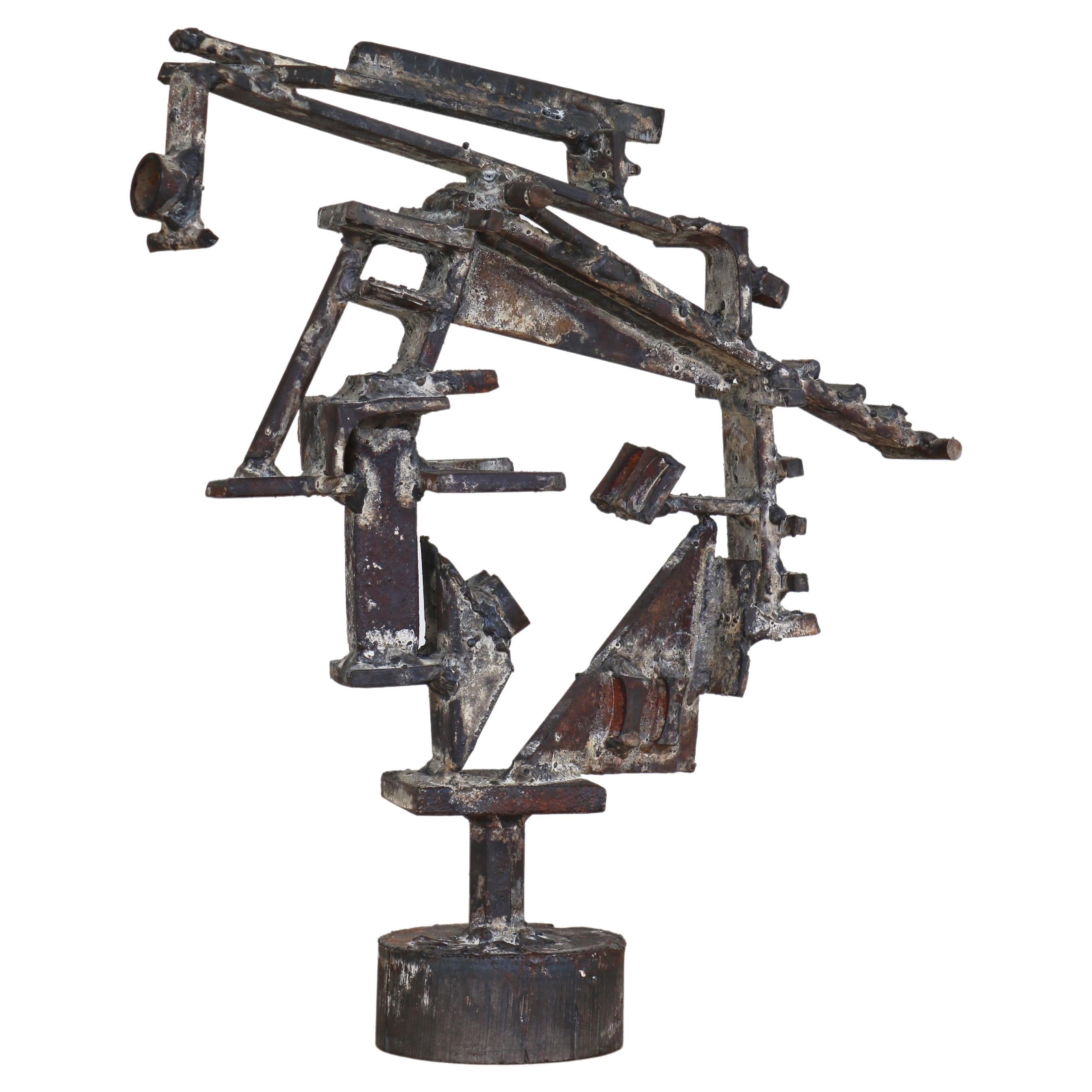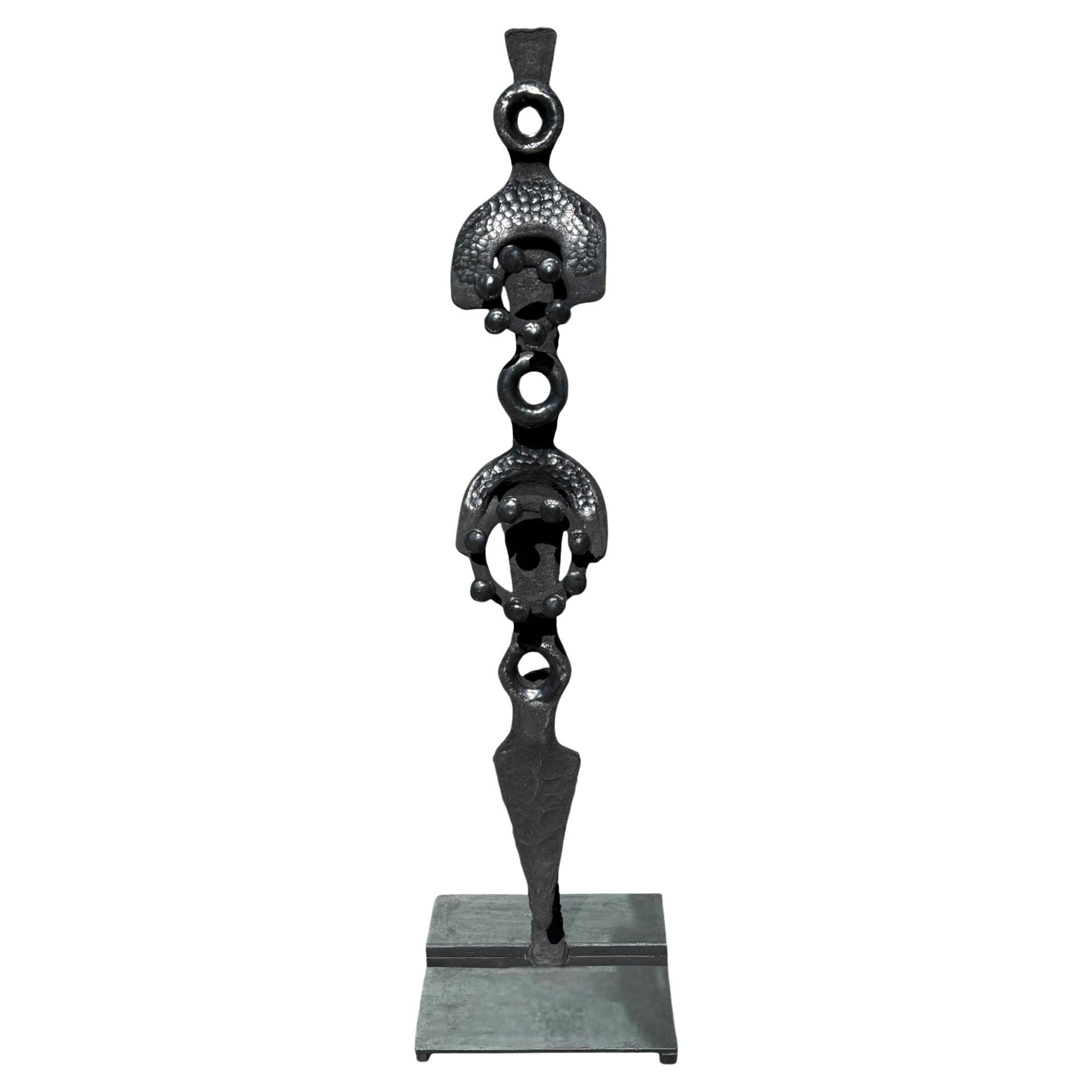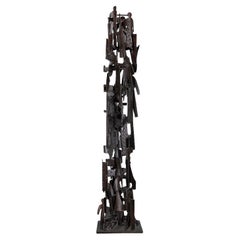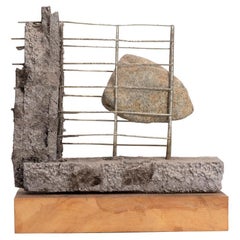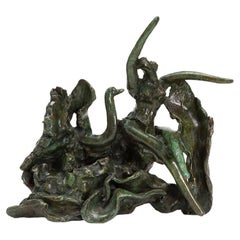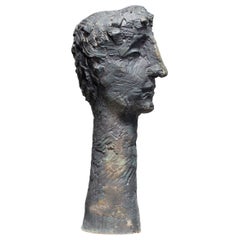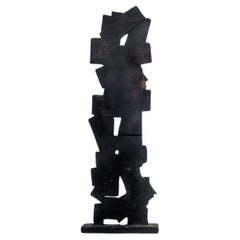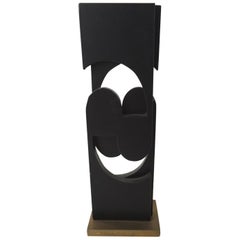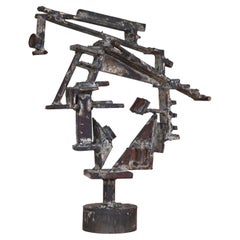Items Similar to Tony Rosenthal Abstract Sculpture Blackened Steel Red Blushes
Want more images or videos?
Request additional images or videos from the seller
1 of 11
Tony Rosenthal Abstract Sculpture Blackened Steel Red Blushes
$6,600
£5,028.10
€5,738.26
CA$9,274.56
A$10,107.64
CHF 5,352.43
MX$121,403.41
NOK 67,762.97
SEK 62,301.38
DKK 42,858.41
About the Item
SALE ONE WEEK ONLY
UNTITLED is an abstract blackened steel sculpture that has a continuous lively movement. The positioning of the heavy metal is suggestive of dance. There are similarities to the sculptors, Robert Sestok and Tony Smith, who both worked in bronze and painted steel with similar cut out pieces and abstract designs. Untitled has a joyous aura and its small size makes it a charming intimate piece. It might have been a maquette for a much larger piece. The design works in this 14" height as it would in a 14' height. There is a Letter of Certification that will accompany the sculpture.
Tony Rosenthal (1914 - 2009) is best known for creating a staggering list of monumental public art sculptures. For over seven decades Tony Rosenthal created an arc of sculpture in a variety of sizes, styles and media, including wood, steel, bronze, brass, cement and aluminum. Every day millions see, enjoy and interact with art created by Rosenthal in cities around the world. In New York City alone, five Rosenthal public art sculptures have been beloved and visible 24/7 for over four decades, yet Rosenthal is not a household name. Art dealer Joseph K. Levene, told The New York Times, Tony Rosenthal "reminds me of a character actor. You know the face but not the name. With him, you know the art."
Tony Rosenthal dedicated his life to creating art and actively created sculpture everyday in his Southampton, New York studio until he passed away at the age of 94, July 28, 2009. At nine Rosenthal learned the fundamentals of carving sculpture when his mother, an opera singer enrolled him in children's classes at the Art Institute of Chicago where he learned how to carve sculptures in soap. In 1936 Rosenthal earned a B.F.A. from the University of Michigan, and in 1952 became the first instructor of sculpture at the University of California, Los Angeles. In 1950 Rosenthal was recipient of the San Francisco Museum of Modern Art’s sculpture award; in 1967, Rosenthal received the outstanding achievement award from the University of Michigan and in 1963 a Ford Foundation Grant.
After graduating from the University of Michigan, Rosenthal became studio assistant to Alexander Archipenko, the figurative master sculptor, casting bronzes in exchange for sculpture lessons; at night, Rosenthal taught evening classes in drawing and sculpture. In 1939, Rosenthal enrolled at Cranbrook Academy of Art, studying with Carl Milles, Cranbrook's sculptor in residence; there, Rosenthal forged friendships with husband and wife designers Charles Eames and Ray Eames and the sculptor Lilian Swann Saarinen the wife of architect, Eero Saarinen.
Decades later Rosenthal acknowledged his gratitude to Cranbrook by donating his archives to them. The Cranbrook Cube, 1984, a 90" painted aluminum cube is in the Cranbrook Museum collection. In 1942, Rosenthal was drafted into the U.S. Army; while stationed in Paris Rosenthal forged friendships with George Braque, Andre Derain, Le Corbusier and Constantin Brancusi, routinely organizing and accompanying groups of soldiers on studio visits. Through multiple visits to Brancusi's Paris studio, Rosenthal learned to create and forge metal sculpture. After World War II, Rosenthal moved to Los Angeles, continuing his association with John Entenza and Charles and Ray Eames who introduced Rosenthal to architects who commissioned his public art during the 40's and 50's.
Named public art legend by Sam Hunter, emeritus professor of art history at Princeton University and author of Tony Rosenthal, Rizzoli 1999 monograph. Tony has said “I like to make public sculptures in which people can participate, that have a functional purpose as well as an esthetic one" Rosenthal told Grace Glueck, art reporter, The New York Times June 27, 1980. After creating “A Nubian Slave,” 1939, a 14’ plaster figurative sculpture commission for the Elgin Watch Building at the 1939 New York World’s Fair, Tony Rosenthal embarked on a storied 70 year public art career, creating an arc of public art, deco inspired sculpture in the 30’s and 40’s, figurative sculpture during the 50’s and abstract minimalism for the remainder of his career.
- Creator:Tony Rosenthal (Artist)
- Dimensions:Height: 14 in (35.56 cm)Width: 11 in (27.94 cm)Depth: 4 in (10.16 cm)
- Style:Modern (Of the Period)
- Materials and Techniques:
- Place of Origin:
- Period:
- Date of Manufacture:1998
- Condition:
- Seller Location:Bloomfield Hills, MI
- Reference Number:1stDibs: LU7781233542912
About the Seller
5.0
Vetted Professional Seller
Every seller passes strict standards for authenticity and reliability
1stDibs seller since 2022
20 sales on 1stDibs
- ShippingRetrieving quote...Shipping from: Detroit, MI
- Return Policy
More From This Seller
View AllRobert Sestok "Cass Corridor Artist" Detroit Abstract Welded Steel
By Robert Sestok
Located in Bloomfield Hills, MI
The "Untitled" abstract sculpture by Robert Sestok has a very deliberate aura of strength in its columnar shape. Upon closer inspection details emerge su...
Category
Vintage 1980s American Expressionist Abstract Sculptures
Materials
Steel
Robert Bielat Sculpture Cast Bi-Metal Stone Wood "TRUE EAST"
Located in Bloomfield Hills, MI
SALE ONE WEEK ONLY
"Robert Bielat was an artist’s artist, a sobriquet applied to those whose work is brilliant but idiosyncratic, deeply compelling in a way that is obvious to those who can see it, but not necessarily so to the market or to the arbiters...
Category
21st Century and Contemporary American Expressionist Abstract Sculptures
Materials
Stone, Cast Stone, Metal, Aluminum
Ruben Nakian Bronze Figurine "Leda and the Swan" Limited Edition
By Reuben Nakian
Located in Bloomfield Hills, MI
SALE ONE WEEK ONLY
“Leda and the Swan” is by Reuben Nakian (1897 - 1986). He was an American sculptor and teacher of Armenian extraction. His works’ recurring themes are from Greek and Roman mythology. Nakian’s small bronzes achieve majesty and power which are not dependent on size and amplitude. With characteristic freshness, he has reinterpreted the classical subject of Leda and the Swan refining it in the Classical-Renaissance-Baroque tradition in a contemporary way. Dr. Robert P. Metzger gives us his aesthetic interpretation of this work which retells the myth in classical hedonism and freedom of expression showing Leda and the Swann prior to her being ravaged and during their first meeting. “The young virgin is fascinated with her new found friend and accepts him in a spirit of playfulness, contentment and wonder. She is dreamily available and shyly seductive as the deceptively tame swan snuggles up to her with its phallic-like neck.” Leda appears composed, placid yet open and available as compared to her more intense and passionate states in other of Nakian’s depictions on the same theme. This was cast at the "Renaissance Art Foundry" in 1978 and is so marked on the base being #5 of 7.
It is believed that “no other sculptor of the twentieth century matched Rueben’s heroic renditions with the grand themes of Western Art. His erotic mythological figures exude a joyous energy of gesture and movement which place them among seminal sculptural achievements of the past one hundred years.”
Nakian studied at the Independent School of Art in New York City previously known as the Robert Henri School … with Homer Boss...
Category
Vintage 1970s American Figurative Sculptures
Materials
Bronze
Judy Brady Sculpted Ceramic Head
Located in Bloomfield Hills, MI
The UNTITLED portrait sculpture has a quiet yet powerful and commanding aura. The viewer cannot be around or near it without feeling its presence. It has a very classical approach in...
Category
Vintage 1970s American Expressionist Busts
Materials
Ceramic, Paint
Edgardo Simone Nude Figurative Sculpture "THE KISS"
By Edgardo Simone
Located in Bloomfield Hills, MI
SALE ONE WEEK ONLY
Edgardo Simone (Italian/American, 1890-1948) The Kiss patinated plaster casting sculpture for kissing nudes fountain sculpture signed to top of base.
Classically trained in Italy at the Beaux Arts Academy in Rome from 1906 to 1913, Edgardo Simone became a famous sculptor in Italy and the United States using mediums of terracotta, ceramic, bronze, and plaster. He earned a Doctorate of Design and Sculpture at the Academy and then emigrated to the United States where he worked in New York, Chicago and southern California.
His style was influenced by Art Nouveau, Art Deco and other modernist influences. In Italy he had received three times the Croix de Guerre and was decorated by King Victor Emmanuel II and Queen Margherita. Before moving to America, he had much recognition in Italy. He had created war, funeral and city monuments in twenty-six Italian cities. When he arrived in New York City, one of the newspapers carried a headline: "Italy's greatest Sculptor Arrives in New York."
In New York, Simone became prominent in society and did many portrait busts including of Thomas Edison, John J. Pershing, Henry Ford and Louis Brandeis...
Category
Early 20th Century North American Art Nouveau Figurative Sculptures
Materials
Plaster
"Goberg Candlesticks" Steel, Iron, Patina, Rare, 1900's, Art Nouveau, Pair
By Goberg
Located in Bloomfield Hills, MI
"Goberg Candlesticks" Steel, Iron, Patina, Rare, 1900's, Art Nouveau, Pair
The exquisite rare antique candlesticks are an ARTS & CRAFT Art Nouveau pair signed GOBERG a Hugo Berger wr...
Category
Antique Early 1900s Austrian Art Nouveau Candlesticks
Materials
Metal, Steel, Iron
You May Also Like
Tony Rosenthal Tabletop Bronze Sculpture
By Tony Rosenthal
Located in Chicago, IL
Tony Rosenthal Tabletop Bronze Sculpture
Untitled. Vertically oriented black painted bronze sculpture with three interior voids with irregular edges welded to base, signed, circa 19...
Category
1990s Abstract Sculptures
Materials
Metal
1998 Italy Postmodern Bronze Abstract Sculpture by Roberto Vecchione
By Roberto Vecchione 1
Located in Brescia, IT
Roberto Vecchione is an Italian artist that explore the world between the empty and full, the yes and no with a conceptual language called "New Baroque".
H...
Category
1990s Italian Post-Modern Abstract Sculptures
Materials
Brass, Iron
Abstract black steel patinated sculpture by the designer Michel Froment, 2025
By Michel Froment
Located in NICE, FR
This ultra-contemporary work by Michel Froment unfolds as a subtle dialogue between modernity and primitivism, between universal forms and archaic energy. Crafted from steel-type met...
Category
21st Century and Contemporary French Primitive Abstract Sculptures
Materials
Steel
Scandinavian Abstract Modernism Iron Sculpture by Erik Aalykke, Denmark, 1960s
Located in Odense, DK
Unique sculpture handmade by Danish artist Erik Aalykke in his own studio in the 1960s. The piece is made from acid treated iron with a beautiful patina.
Erik Aalykke (1923-83) used...
Category
Vintage 1960s Danish Scandinavian Modern Abstract Sculptures
Materials
Iron
Abstract Steel Sculpture
Located in Houston, TX
Abstract Steel Sculpture.
Offered is a stunning Organic Modern abstract patinated steel sculpture.
This beautiful sculpture after the work of David Hayes can be used indoors out as a...
Category
20th Century American Industrial Abstract Sculptures
Materials
Cut Steel
$3,600
Abstract black steel patinated sculpture by the designer Michel Froment, 2025
By Michel Froment
Located in NICE, FR
This ultra-contemporary work by Michel Froment unfolds as a subtle dialogue between modernity and primitivism, between universal forms and archaic energy. Crafted from steel-type met...
Category
21st Century and Contemporary French Primitive Abstract Sculptures
Materials
Steel
More Ways To Browse
Vintage 1939 New York Worlds Fair
Elgin Vintage
Carl Mill
Carl Milles
Vintage Elgin Watch
Aluminum Cubes
Rosenthal Red
Pendulum Sculpture
Saint Ambrose
Steel Glass Sculpture Of Butterfly
Table Sculpture Geometric
Teal Glass Sculpture
Vera Want
1950s Abstract Ceramic Sculpture
American School Sculpture
Andree And Michel Hirlet
Art Brut Sculpture
Bas Relief Abstract
